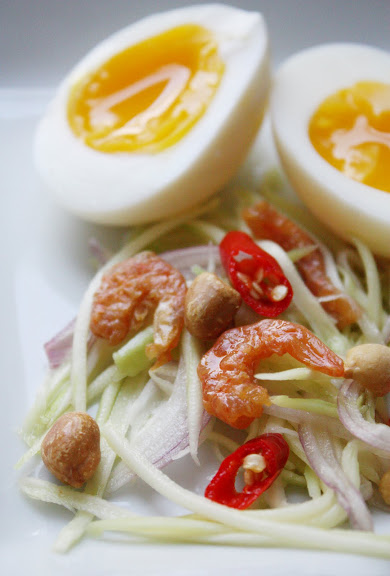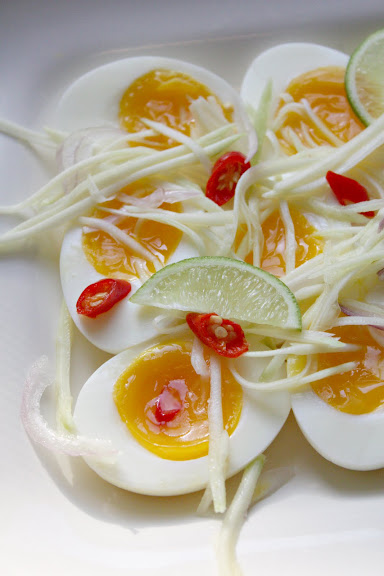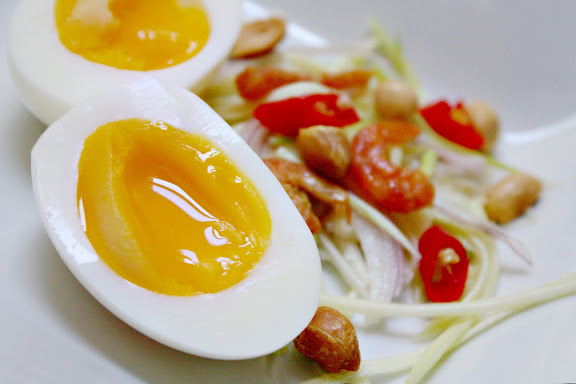
My friend raised his eyebrows when I casually mentioned to him that most of the Thai dishes I make at home were not what you usually found on most Thai restaurants’ menus. “What do you eat?” My friend asked. His eyebrows went all the way up to the hairline now, rendering the forehead almost nonexistent. Take, for example, Pad Thai. Remove that from a Thai’s diet and, as my friend figured, that Thai would be as good as dead.
Pad Thai? Hardly. Take this simple green mango salad from me, though, and watch my soul wither and die.
We love green mangoes over there in Thailand. They are innumerable in variety. Some varieties are meant to be eaten right out of hand. Some are meant to be eaten with a sweet dipping sauce. Some taste best preserved or pickled. The very, very tart ones are usually grated into long, thin strips and turned into a ridiculously simple, yet extremely delicious and versatile salad – green mango salad.
Yam Mamuang (ยํามะม่วง), is usually not served by itself as a salad course; it is served more as a condiment. The tart, salty, hot, mildly sweet flavor combination makes this fresh salad perfect as a side for crispy fried or grilled meats, most common of which is deep-fried flaked catfish, Pla-duk Fu (ปลาดุกฟู).

Personally, I like to pair Yam Mamuang with simple boiled eggs. The eggs must be cooked to the point that is right in the middle between soft-boiled and hard-boiled. The Thai people label eggs boiled to this exact degree of doneness “ไข่ต้มยางมะตูม” or “ไข่ยางมะตูม,” likening the consistency of the yolks to the viscous resin/gum of the bael fruit (the มะตูม in ไข่ยางมะตูม). On the outside, medium-boiled eggs look exactly like hard-boiled eggs; that is to say, the whites are tender, yet cooked and hold their shape. But once you split them open, you see creamy golden yolks which aren’t nearly as runny as those of soft-boiled eggs. That’s perfect. That’s what I like. That’s what a lot of people like.
And they’re not at all hard to make. All you have to do is the opposite of what you normally do when making hard-boiled eggs which is putting the eggs in a pot of room-temperature water then bring both the eggs and the water to a boil together. For medium-boiled eggs, the only foolproof method which has yielded consistent results — the easiest method — is to:
- Take the eggs out of the refrigerator and leave them out while waiting for the water to boil.
- Bring a pot of water, with a large pinch of salt added, to a boil.
- Gently lower the eggs into the boiling water with a soup ladle (this minimizes the impact in terms of blunt trauma and temperature difference). You will need to turn up the heat to maintain the rolling boil.
- Boil, uncovered, for exactly 7 minutes for large eggs [Added September 23, 2013: chicken eggs. For duck eggs, boil exactly 8 minutes per this post). (Don’t estimate the time. Never guess. Use a timer. Please.) Stir the eggs occasionally to make sure the yolks stay in the middle.
- Immediately remove the pot from heat and drain off the water. Fill the pot with fresh water from the faucet to cool off the eggs then drain off the water; repeat.
The eggs are now ready to be used.
- To make green mango salad, peel and grate a good green mango* and toss it with some thinly-sliced shallots (1 part shallot:3 parts mango ratio works for me). Add some fresh lime juice to taste. (Exact measurement cannot be prescribed, because the acidity levels of various types of green mango vary greatly. The more sour the mango, the less lime juice needed.) Then some fish sauce. A tiny pinch of sugar is good too, especially if you’re dealing with a very tart green mango. Some sliced fresh bird’s eye chillis go in and you’re all set. That’s the minimalist version. To make it more interesting, you can throw in some dried shrimp and roasted peanuts. Cilantro leaveswould be nice, but not an absolute must for me.[Another version that is often used to top crispy fried catfish flakes is made by creating a separate dressing by melting together 4 parts fish sauce: 3 parts fresh lime juice: 1 part sugar. Arrange the salad ingredients over the crispy fish and drizzle the dressing on top of the whole thing. This seems to be the standard procedure for Yam Pla-duk Fu these days. When the mango salad goes on top of the crispy fish, oftentimes roasted cashew nuts are used instead of roasted peanuts.]
Serve the green mango salad on top of the medium-boiled eggs. These and a plate of steamed jasmine rice make for a fine, fine meal. In fact, as far as I’m concerned, Pad Thai has got nothing on it.
*Best places to get these mangoes are South and Southeast Asian grocery stores. Choose ones that are very, very firm. They must be rock hard, in fact. When you lightly squeeze one, it should not yield at all. Also, the skin should be taut and shiny, not wrinkly or spotted.

















